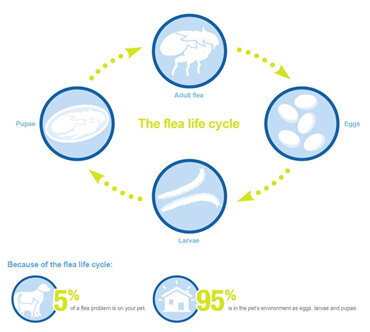As the weather is getting warmer, flea numbers start to rapidly increase. Take a moment to check out these flea facts which explain why fleas have been around for 100 million years, about the same time as the Tyrannosaurus Rex. To start with though, we must understand the flea lifecycle which resembles that of a butterfly.
- Female fleas lay eggs which drop off your pet and land in your environment.
- Eggs then hatch after a variable period into larvae.
- The larvae develop into pupae and settle inside a cocoon.
- They then wait for a host (our dog for example) which is detected by warmth, vibration, and movement. They then rapidly unzip the pupae and jump on to start feeding on the animal’s blood, to complete the cycle.
This cycle takes between 2 weeks and 8 months to complete. This is dependent on the climate – being much quicker in warmer temperatures such as our NZ Spring and Summer. In the average household however, it can only take around 3-4 weeks all year around to complete, especially with household heating in the winter. Five percent of the flea population may be found as adults on your pet; however this means that the remainder of the life cycle (95%) is happening in your house e.g. in the carpets, under beds, in your dog kennel, or in the garden in warm weather!
FLEA FACTS
- A flea can survive without a meal for over 100 days
- A female flea can start laying eggs within 36-48 hours of having a blood feed
- A female flea can lay up to 2000 eggs within her life span
- A female flea can lay up to 50 eggs per day which can lay dormant for up to 6 months or become adult fleas within as little as 2 weeks. If your dog has just 5 fleas this means they can lay 3,500 eggs in 2 weeks – then they start to hatch!!
- A flea can hatch from the pupae and jump onto the dog within 3 seconds
- A flea can jump as high as 1.25 metres – up to 150 times their own height which compares with us doing a 330-metre-long jump!
- A flea consumes over 15 times her body weight daily in blood.
- A flea can bite up to 400 times per day meaning if your dog has 10 fleas, they may be bitten 4000 times per day.
TREATMENT
After reading these facts we must realise it is better to prevent flea infestations than to treat them as once adults are seen, you already have a significant flea burden in your environment and on your pet. Eggs cannot be seen on the coat of your pet as they are very tiny and drop off into the surrounding environment. We can often see tiny black specks throughout your animal’s coat which are flea faeces – basically just dried blood. Symptoms that your pet has fleas will vary between individuals. Some animals may only give the occasional scratch where others are driven mad with intense itching from an allergy to the flea saliva – these animals may cause excessive damage to their coat and skin from constant licking, biting and scratching. Fortunately, there are now many effective and safe flea products available from your vet, that can attack the flea life cycle at different stages. Beware of some cheaper products as they can contain fewer effective ingredients with limited duration of action. There are a variety of different flea products available, ranging from topical applications on the back of your pet to oral palatable products. This market is increasing all the time. These products also have a varying length of duration from 4 weeks to 6 months. All the flea products from your vet have been vigorously tested to ensure they are both safe and effective. Please discuss with your vet the best product to suit you pet.



